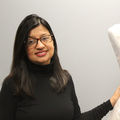Interviews
Sri Lankan handlooms & batik take off in recent years
05 Jan '15
3 min read
Production of handloom textiles as well as batik textiles has taken off in Sri Lanka in recent years.
With the increase in demand from global markets, Sri Lanka is now capable of producing various handloom textile products and batik.
Sri Lankan handloom textile products are exported to various countries like Italy, Germany, France, UK, Norway, Netherlands, Maldives and Thailand, the official Sri Lankan government portal informs.
The combination of traditional designs blended with modern trends in modern material woven in new processing techniques has made export quality handlooms access competitive international markets.
Sri Lanka exports curtaining, table linen, bed linen, kitchen linen, upholstery and dress fabric and other products to foreign markets.
While the demand in the domestic market pertains to products like curtains, table linen, bed linen furnishing, cushion covers, sarongs and sarees.
Books, notebooks, albums, and even writing pads are now clothed with this handcrafted material of textile.
There are around 900 private handloom producers inclusive of small, medium and large-scale are operating in the country, the portal says.
The handloom textile industry is a highly labour intensive and lack of weavers and high production cost has hampered the growth of the industry considerably.
Handloom textiles are produced in Sri Lanka within the confines of a small-scale industry that generate employment to rural women.
In case of batik, introduction of chemical dyes in addition to traditional dyes has led to the spectrum of colours in Batik textiles becoming endless.
Originally a cottage industry, today manufacture of Batik products is done at workshop level in the South-western coastal areas of as well as the Central area of Sri Lanka.
Batik is of Indonesian roots, yet in Sri Lanka, the craft has developed into a unique style to produce shirts, sarongs, dresses, shorts, wall hangings, cushions covers, bed hangers and a multitude of décor items.
The time consuming technique in producing high quality Batik involves multiple waxing and dyeing of fabric on which the design is done.
In the end, all wax is scraped out and then boiled and the fabric is made to absorb colors of the dyes further by the use of hydrochloric acid, while drying in the sun brightens up the colours.
The number of colors in batik is the precise indication of the number of times it was immersed in the dye bath and application and removal of wax.
This indicates that a multicoloured design of Batik involves a great deal of work than a Batik design in just a couple of colours. (AR)
With the increase in demand from global markets, Sri Lanka is now capable of producing various handloom textile products and batik.
Sri Lankan handloom textile products are exported to various countries like Italy, Germany, France, UK, Norway, Netherlands, Maldives and Thailand, the official Sri Lankan government portal informs.
The combination of traditional designs blended with modern trends in modern material woven in new processing techniques has made export quality handlooms access competitive international markets.
Sri Lanka exports curtaining, table linen, bed linen, kitchen linen, upholstery and dress fabric and other products to foreign markets.
While the demand in the domestic market pertains to products like curtains, table linen, bed linen furnishing, cushion covers, sarongs and sarees.
Books, notebooks, albums, and even writing pads are now clothed with this handcrafted material of textile.
There are around 900 private handloom producers inclusive of small, medium and large-scale are operating in the country, the portal says.
The handloom textile industry is a highly labour intensive and lack of weavers and high production cost has hampered the growth of the industry considerably.
Handloom textiles are produced in Sri Lanka within the confines of a small-scale industry that generate employment to rural women.
In case of batik, introduction of chemical dyes in addition to traditional dyes has led to the spectrum of colours in Batik textiles becoming endless.
Originally a cottage industry, today manufacture of Batik products is done at workshop level in the South-western coastal areas of as well as the Central area of Sri Lanka.
Batik is of Indonesian roots, yet in Sri Lanka, the craft has developed into a unique style to produce shirts, sarongs, dresses, shorts, wall hangings, cushions covers, bed hangers and a multitude of décor items.
The time consuming technique in producing high quality Batik involves multiple waxing and dyeing of fabric on which the design is done.
In the end, all wax is scraped out and then boiled and the fabric is made to absorb colors of the dyes further by the use of hydrochloric acid, while drying in the sun brightens up the colours.
The number of colors in batik is the precise indication of the number of times it was immersed in the dye bath and application and removal of wax.
This indicates that a multicoloured design of Batik involves a great deal of work than a Batik design in just a couple of colours. (AR)
Fibre2fashion News Desk - India
Popular News
Leave your Comments
Editor’s Pick
Christian Guinet
French Textile Equipment Manufacturers’ Association (UCMTF)
Ritesh Dodhia
Dodhia Synthetics Limited
































-Ltd..jpg?tr=w-120,h-60,c-at_max,cm-pad_resize,bg-ffffff)





.jpg?tr=w-120,h-60,c-at_max,cm-pad_resize,bg-ffffff)
.jpg?tr=w-120,h-60,c-at_max,cm-pad_resize,bg-ffffff)






